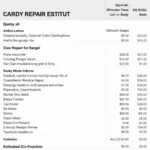Adhesive glue car body repair offers a modern alternative to traditional welding methods. This guide dives deep into the world of adhesive glue for car body repair, exploring its advantages, applications, and best practices.
Understanding Adhesive Glue in Car Body Repair
Adhesive glue has revolutionized the car body repair industry, offering a quicker, stronger, and more versatile solution compared to traditional welding techniques. These advanced adhesives provide superior bonding strength, excellent corrosion resistance, and improved structural integrity. They are particularly useful for repairing smaller damages like dents, cracks, and panel replacements. Using adhesive glue also reduces the need for extensive bodywork, saving both time and money. Choosing the right adhesive glue for your car body repair is crucial for a successful and long-lasting repair. car body out pooler repairing tools can be used in conjunction with adhesives for a complete repair solution.
Advantages of Using Adhesive Glue
- Increased Strength and Durability: Modern adhesive glues offer exceptional bonding strength, often exceeding that of welds. This results in a more durable and long-lasting repair.
- Improved Corrosion Resistance: Adhesive glues create a sealed bond that prevents moisture and air from reaching the metal, effectively minimizing the risk of rust and corrosion.
- Reduced Heat Distortion: Unlike welding, adhesive glue application doesn’t involve high heat, eliminating the risk of warping or distorting the surrounding metal panels. This makes it ideal for repairs in sensitive areas.
- Faster Repair Times: Applying adhesive glue is generally faster than welding, reducing the overall repair time and getting your vehicle back on the road sooner.
- Versatility: Adhesive glues can be used on various materials, including steel, aluminum, and plastic, making them suitable for a wide range of car body repairs.
Choosing the Right Adhesive Glue
Selecting the correct adhesive glue is paramount for a successful car body repair. Factors to consider include the type of materials being bonded, the extent of the damage, and the environmental conditions. Two-part epoxy adhesives are popular for their high strength and durability, while polyurethane adhesives are known for their flexibility and gap-filling properties. Consult with a professional or refer to the manufacturer’s recommendations to determine the most suitable adhesive for your specific repair needs. When dealing with dents, a car body paintless dent lifter repair tool might be a suitable option.
Applying Adhesive Glue Correctly
Proper surface preparation is crucial for effective adhesion. The area to be bonded must be clean, dry, and free of rust, grease, and any other contaminants. Applying the adhesive glue according to the manufacturer’s instructions is essential for achieving optimal bond strength. This typically involves mixing the two components in the correct ratio (for two-part adhesives) and applying an even layer to the bonding surfaces. Clamping or fixturing the parts together until the adhesive cures is also necessary to ensure proper bonding.
Adhesive Glue Car Body Repair vs. Welding
While both adhesive glue and welding serve the purpose of joining metal parts in car body repair, they have distinct characteristics. Welding involves melting the base metals and using a filler material to create a joint, while adhesive glue creates a bond through chemical adhesion. For smaller repairs and situations where heat distortion is a concern, adhesive glue often presents a more advantageous solution. If you’re considering car body repair without welding uk, adhesive glue might be the ideal choice.
“Using the right adhesive is like choosing the right foundation for a house. It’s essential for strength and longevity,” says automotive expert, Dr. James Carter, PhD in Materials Science.
Best Practices for Adhesive Glue Car Body Repair
- Always follow the manufacturer’s instructions for the specific adhesive glue being used.
- Ensure proper surface preparation to achieve optimal adhesion.
- Use appropriate clamping or fixturing techniques to maintain pressure during curing.
- Consider the environmental conditions, such as temperature and humidity, which can affect the curing process.
- For larger repairs or structural components, consult with a qualified auto body repair professional. If you are looking for the best epoxy for car body repairs, research and consult professionals.
“Adhesive technology has significantly improved the efficiency and quality of car body repairs. It’s a game-changer for the industry,” notes Sarah Miller, a seasoned auto body repair technician.
Conclusion
Adhesive glue car body repair represents a significant advancement in automotive repair technology. Its advantages in terms of strength, corrosion resistance, speed, and versatility make it a compelling alternative to traditional welding methods. By understanding the different types of adhesives, proper application techniques, and best practices, you can achieve professional-grade results in your car body repairs. If you’re dealing with popped-out sections, consider exploring car body pops out repairing tools.
FAQ
- Is adhesive glue as strong as welding for car body repair?
- What are the different types of adhesive glues used in car body repair?
- How do I prepare the surface for adhesive glue application?
- How long does it take for adhesive glue to cure?
- Can I use adhesive glue on all types of car body materials?
- What are the safety precautions when using adhesive glue?
- When should I consult a professional for adhesive glue car body repair?
Need assistance? Contact us via WhatsApp: +1(641)206-8880, Email: [email protected]. We offer 24/7 customer support.

